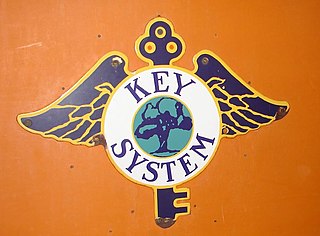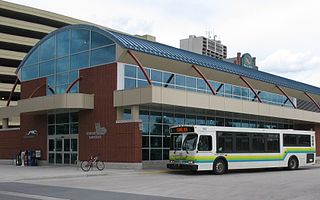
The Southeastern Pennsylvania Transportation Authority (SEPTA) is a regional public transportation authority that operates bus, rapid transit, commuter rail, light rail, and electric trolleybus services for nearly 4 million people in five counties in and around Philadelphia, Pennsylvania. It also manages projects that maintain, replace and expand its infrastructure, facilities and vehicles.

The Key System was a privately owned company that provided mass transit in the cities of Oakland, Berkeley, Alameda, Emeryville, Piedmont, San Leandro, Richmond, Albany, and El Cerrito in the eastern San Francisco Bay Area from 1903 until 1960, when it was sold to a newly formed public agency, AC Transit. The Key System consisted of local streetcar and bus lines in the East Bay, and commuter rail and bus lines connecting the East Bay to San Francisco by a ferry pier on San Francisco Bay, later via the lower deck of the Bay Bridge. At its height during the 1940s, the Key System had over 66 miles (106 km) of track. The local streetcars were discontinued in 1948 and the commuter trains to San Francisco were discontinued in 1958. The Key System's territory is today served by BART and AC Transit bus service.

The Champaign–Urbana Mass Transit District is a mass transit system that operates in the Champaign–Urbana metropolitan area in eastern Illinois. MTD is headquartered in Urbana and operates its primary hub at the intermodal Illinois Terminal in downtown Champaign. In 2021, the system had a ridership of 5,551,500, or about 21,600 per weekday as of the second quarter of 2022.

The San Francisco Transbay Terminal was a transportation complex in San Francisco, California, United States, roughly in the center of the rectangle bounded north–south by Mission Street and Howard Street, and east–west by Beale Street and 2nd Street in the South of Market area of the city. It opened on January 14, 1939 as a train station and was converted into a bus depot in 1959. The terminal mainly served San Francisco's downtown and Financial District, as transportation from surrounding communities of the Bay Area terminated there such as: Golden Gate Transit buses from Marin County, AC Transit buses from the East Bay, and SamTrans buses from San Mateo County. Long-distance buses from beyond the Bay Area such as Greyhound and Amtrak also served the terminal. Several bus lines of the San Francisco Municipal Railway connected with the terminal.

The Illinois Terminal Railroad Company, known as the Illinois Traction System until 1937, was a heavy duty interurban electric railroad with extensive passenger and freight business in central and southern Illinois from 1896 to 1956. When Depression era Illinois Traction was in financial distress and had to reorganize, the Illinois Terminal name was adopted to reflect the line's primary money making role as a freight interchange link to major steam railroads at its terminal ends, Peoria, Danville, and St. Louis. Interurban passenger service slowly was reduced, ending in 1956. Freight operation continued but was hobbled by tight street running in some towns requiring very sharp radius turns. In 1956, ITC was absorbed by a consortium of connecting railroads.

The Illinois Terminal is an intermodal passenger transport center located at 45 East University Avenue in Champaign, Illinois, United States. The facility opened in January 1999, and provides Amtrak train service and various bus services to the Champaign-Urbana area.

Transit Windsor provides public transportation in the city of Windsor, Ontario, Canada as well as LaSalle, Essex, Kingsville, Amherstburg and Leamington and serves more than 6 million passengers each year, covering an area of 310 km2 (120 sq mi) and a population of 218,000. They operate a cross border service between the downtown areas of Windsor and Detroit, Michigan via the Tunnel Bus, and service to events at Detroit's Comerica Park, Little Caesars Arena, TCF Center, and Ford Field. The Windsor International Transit Terminal neighbours with the Windsor International Aquatic and Training Centre.

The Louisville Railway Company (LRC) was a streetcar and interurban rail operator in Louisville, Kentucky. It began under the name Louisville City Railway in 1859 as a horsecar operator and slowly acquired other rival companies. It was renamed in 1880 following the merger of all Mule operations as the Louisville Railway Company. All tracks were 5 ft gauge.

GoRaleigh is the transit system responsible for operating most of the public transportation services in Raleigh, North Carolina. The system operates 27 fixed routes throughout the city's municipal area and also operates five regional/express routes in partnership with GoTriangle, the regional provider. GoRaleigh is contracted to operate two additional routes, an express route to the Wake Tech Community College campus south of Raleigh and a local circulator service in the Town of Wake Forest. Capital Area Transit, also known as CAT, was rebranded to GoRaleigh in 2015 under the consolidated GoTransit, a joint branding of municipal and regional transit systems for the Research Triangle. In 2021, the system had a ridership of 4,173,800, or about 15,500 per weekday as of the second quarter of 2022.
The Chicago and Joliet Electric Railway, or C&JE, was an electric interurban railway linking the cities of Chicago and Joliet, Illinois. It was the only interurban between those cities and provided a link between the streetcar network of Chicago and the cities along the Des Plaines River Valley in north central Illinois, which were served by the Illinois Valley Division of the Illinois Traction System.
Transportation in Indianapolis consists of a complex network that includes a local public bus system, several private intercity bus providers, Amtrak passenger rail service, four freight rail lines, an Interstate Highway System, two airports, a heliport, bikeshare system, 115 miles (185 km) of bike lanes, and 116 miles (187 km) of trails and greenways. The city has also become known for its prevalence of electric scooters.

The South Bend Public Transportation Corporation is a municipal bus system that serves the cities of South Bend and Mishawaka, as well as the nearby suburbs of Notre Dame and Roseland, in the very north of the U.S. state of Indiana. It is the most recent incarnation of the South Bend Railway Company, a street railway company that was founded on May 25, 1885. Transpo receives funding from local, state and federal taxes. In 2021, the system had a ridership of 987,900, or about 3,800 per weekday as of the second quarter of 2022.
The Greater Peoria Mass Transit District is a mass transit district based in Peoria, Illinois; the district itself also includes Peoria Heights and West Peoria. It was established in 1970 and, prior to adopting the name CityLink, it was known as GPTransit. Regularly scheduled fixed route bus service is operated under the name CityLink, with the paratransit service being CityLift, and rural transportation service being CountyLink. In 2021, the system had a ridership of 1,607,100, or about 4,500 per weekday as of the second quarter of 2022.

The Quad Cities MetroLINK, officially the Rock Island County Metropolitan Mass Transit District, provides mass transportation for the Illinois half of the Quad Cities metro area. Both Iowa cities that make up the region have their own systems, but one MetroLINK route does connect with Davenport, Iowa. It is the only transit system in the Quad Cities that operates seven days a week and holidays. The system has a fleet of 60 fixed route buses that is composed of twenty-five 30-foot compressed natural gas buses, eight 40-foot compressed natural gas buses and twenty-two 40-foot diesel buses. As of 2019, they have eight all electric buses. Its annual ridership is 3.5 million.

Knoxville Area Transit (KAT) is the operator of public transportation in Knoxville, Tennessee. Twenty-five routes operate. Service on KAT routes operate weekdays and Saturdays with routes 11, 12, 20, 22, 23, 31, 33, 34 and 41 and 42 offering Sunday service. All routes, except for routes 13,16, 19, 44 and 90 start at the Knoxville Station in Downtown. The Knoxville Trolley is a free shuttle service which provides service to the university and the downtown area. KAT formerly operated the transit service for the University of Tennessee, known as The T. In 2021, the system had a ridership of 1,990,600, or about 6,900 per weekday as of the second quarter of 2022.

The Rockford Mass Transit District is the public transportation operator for the metro area of Rockford, Illinois. Service is provided six days per week along 19 routes, with several of these routes being combined into five Sunday routes that service a large portion of the system. The core of the system is contained in The City Loop, which interconnects with every other service. In 2021, the system had a ridership of 840,200, or about 3,300 per weekday as of the second quarter of 2022.

The Fort Wayne Public Transportation Corporation (FWPTC), branded as Citilink, is the public transportation operator for the metro area of Fort Wayne and Allen County, Indiana. Transportation is provided Monday through Saturday on twelve fixed route lines plus two deviation routes. Citilink does not operate on Sundays and six holidays.

The Decatur Public Transit System is the primary provider of mass transportation in Macon County, Illinois. Fourteen main routes, plus one downtown shuttle using replica trolleys, serve the region.
Quincy Transit Lines is the primary provider of mass transportation in Adams County, Illinois with four routes serving the region. As of 2019, the system provided 347,194 rides over 47,465 annual vehicle revenue hours with 8 buses and 8 paratransit vehicles.
Go West Transit is the primary provider of mass transportation in McDonough County, Illinois with routes serving Western Illinois University and the Macomb area. The system runs 17 routes with over 100 stops and is the only fare-free transit system in Illinois. As of 2019, the system provided 841,943 rides over 45,934 annual vehicle revenue hours with 18 buses and 10 paratransit vehicles.















